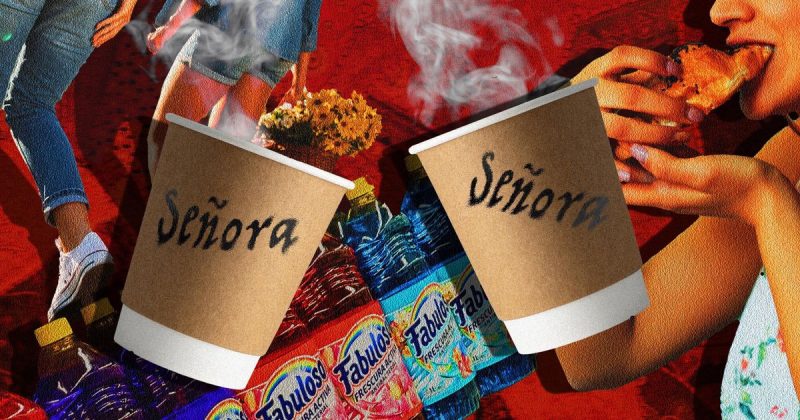The Hidden Mental Health Benefits Of Embracing Your ‘Señora Era’ Early

“Entering my señora era” is a phrase that has become popular on TikTok to describe the habits that younger Latinxs grew up seeing their moms, tías and abuelas do ― and now they’re doing them, too.
Do you have a sudden passion for gardening, cleaning or watching people out your window as you sip your cafecito and eat your pastry? You might be in your señora era. It can mean staying at home in your bata (nightgown) instead of going out, or appreciating simple pleasures like slow walks and chisme (gossip) with your friends.
It’s an abuelita aesthetic with a modern twist.
Los Angeles-based Mollie Daniela said for her it’s a reminder to “live more slowly in order to value things like family.” In her TikTok, she’s sipping a hot drink in a bata while the caption reads: “Life got too stressful. I’m starting my señora era at 22.”
For Daniela, channeling her inner señora is also a way to connect to family she never met.
“I never got to meet my grandparents because they passed away when I was very little, and this helps me feel connected to them as my parents have shared stories about them,” Daniela told HuffPost. “Specifically my grandma, Mollie, whom my mother named me after and who also loved to wear batas like the one I’m wearing in the video.“
Why younger Latinxs are embracing their “señora era.”
Traditionally a señora represents an older woman, often married, who acts as a matriarch and caretaker of the home. But for the new generations of señoras, it goes beyond gender ― it’s a mindset.
Caroli, a 29-year-old Mexican who lives in New York City, is nonbinary and identifies with being a señora. For them, it’s a way to embrace “all the little teachings that I had from my mom, my grandma, and being like, ‘Oh, this is not a bad thing that this exists within me.’ And it actually feels very home-y to let it out.”
One big señora activity? Taking care of your home. Caroli, who asked to not share their full name for privacy, posted a TikTok of when they woke up early to clean their apartment balcony with Fabuloso, because it reminded them of how they would wake up to their mom throwing buckets filled with the same cleaning product onto the family patio.
“I was like ‘Oh, wow, I feel exactly like my mother right now,’” Caroli said.
In this way, doing señora activities can also conjure past memories.
“I lost my grandma almost 12-13 years ago. But I know I’m in my señora headspace when I feel her with me. I also miss my mom,” Caroli said. “You know you’re in it when you feel connected to a powerful female, femme-presenting figure that was once in your life, or that is in your life.”
For Caroli, channeling their inner señora reminds them of when their grandmother hosted huge family dinners. “She may have been serving us and taking care of us. But that woman was in control of everything that happened that day,” Caroli said.
That’s why for Caroli, entering a señora headspace “helps me feel like I am in control of something, and I am keeping something together, mostly for myself, but also for others.”
The mental health benefits of being in your señora era.
Saying that you’re in your señora era is not just for TikToks, and practicing it doesn’t just mean staying inside and unwinding. It can also send out a bat signal for the kind of like-minded people you’re hoping to meet, too ― which comes with a host of mental health perks.
Brooklyn, New York City, roommates Jaqueline Padilla and Alexis Mendias are two recent California transplants who were missing the ease with which they were able to hang out with nearby cousins and friends back in the West Coast. One night in their apartment, the two Mexican Americans decided to create their own meetup group called City Señoras.
Padilla said that for her, a city señora is someone who balances solo self-care along with connecting with others. “They focus mainly on their mental health, whether that be needing a night in and just lighting your candle, having your little tea, watching the show that you want, or it could be hitting up your comadres [friends] and being like, ‘Hey, I need a night out dancing.’ And that’s also a form of self-care.”
Their first event to play the bingo-like game of Lotería at McCarren Park with fellow city señoras this summer was “humbling,” Mendias said. No one else showed up. But the pair didn’t give up on their plan to “get the señoras out of the house.”
They decided their next event would involve a classic señora activity of grabbing a cafecito and walking to a park.
“In my mom’s pueblo where she’s from, you go and you walk to la plaza. Walking is a thing, like, ‘I’m gonna go and socialize or just people-watch kind of thing,’” Mendias said.
This time, Mendias promoted the event in a TikTok, and notifications blew up. About 70 people showed up to grab coffees, walk in Central Park and play Lotería. They wanted their señora era too.
“During the walk…there were girls that were saying, ‘I literally always save events and never show up. But I really wanted to meet other girls like me. And so that’s why I’m here,’” Padilla recalled.
“I was just so proud of how many of us there were, like blasting Spanish music unapologetically and just taking up space, so comfortably and so naturally with strangers. A lot of people who went came solo,” Mendias said. “And they found other comadres [friends], other señoras who also value that self-care time and also want to be outside of their comfort zone.”
Simple señora pleasures like walking and chatting with friendly strangers in your city can actually have big mental health benefits. A 2020 study in The Journal of Environmental Psychology found that a 30-minute walk in a city park lowered how much people ruminate on negative thoughts.
“These activities are very soothing for the nervous system, whether it’s gardening, enjoying your cup of coffee, going on a walk ― all of these activities that are trending under the señora era are essentially tapping into one of our five senses,” said Adriana Alejandre, a California-based licensed marriage and family therapist and founder of Latinx Therapy.
In this way, claiming your señora era can help you find balance within yourself, and find other people on a similar journey.
“In the past, people entered their señora era through age. And because of the pandemic, I feel like we just really had to reevaluate ourselves. And so now we’re choosing to prioritize ourselves,” Padilla said.
Why embracing your señora era in young adulthood can be healing.
There are parts within the señora trope that younger señoras would like to leave behind. Andrea Lopez, a 25-year-old Dominican American who attended a City Señoras “Samba and Sips” event, said that when you claim the señoras title, you’re signaling that you’re in your “responsible era.”
“It’s an era where you’re committing to finding yourself,” Lopez said.
That dedication is the señora mindset she wants to embrace, but she does not want to be part of the sacrificial symbol that señoras are often tied to.
“If you read our classic Latin American books in our history, the role of the señora is usually one of sacrifice. Usually she sacrifices her own dreams and desires to put her family first,” Lopez said.
“People may not be realizing that it’s also healing for their inner child, their little señorita.”
– Adriana Alejandre, therapist
It’s part of a cultural script known as “marianismo,” which pressures Latinas to center the lives around their families and homes, and encourages passivity, self-sacrifice and chastity. Alejandre said under marianismo, women are expected to respect patriarchal values and “be as close as possible to the Virgin Mary.”
“I think this trend and everyone’s awareness of it is kind of debunking the unhealthy parts of our culture as well,” Alejandre said.
She noted that children often get stuck doing chore-like señora activities like cleaning, cooking and gardening, which is why it can be healing for adult señoras to now do these activities on their terms ― not their families’.
“Now as adults, because we have this sense of control and independence, and physical boundaries from our families, we’re able to recreate these activities in a way that feels healthy for us,” she said.
“It’s healing in the present, but also, people may not be realizing that it’s also healing for their inner child, their little señorita,” Alejandre continued.
Choosing which parts of your heritage you want to honor and transform is what makes the new wave of señoras different.
“It’s a really great way to connect the older generations to the younger generations and finding some common ground, being like, ‘Oh, it doesn’t take for you to be in your 50s to have a little cafecito and chisme time with your friends,’” Caroli said. “Like we’ve been doing it since we were kids. It’s just never been embraced or appreciated in the way that it is today.”
“A common theme right now is breaking generational curses,” Lopez said. “We’re learning to strike a balance between fitting in with that family history, but also healing ourselves and therefore healing our future generations of señoras.”








